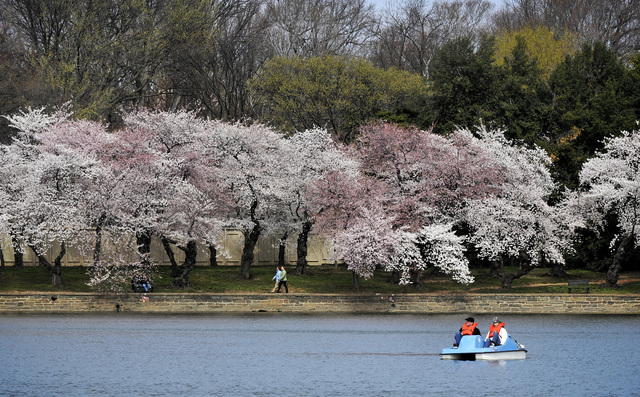WASHINGTON — Countries in East Asia continuously squabble over everything from history textbooks to empty rocks in the sea. So don’t be too surprised that the beautiful spectacle of cherry blossom season is also a matter of nationalist dispute. ADVERTISING
WASHINGTON — Countries in East Asia continuously squabble over everything from history textbooks to empty rocks in the sea. So don’t be too surprised that the beautiful spectacle of cherry blossom season is also a matter of nationalist dispute.
The elegant flowers have long been associated with Japanese culture and aesthetics, a graceful metaphor for the ephemeral nature of life. More than a century ago, Japanese authorities gifted Washington 3,000 cherry trees to brighten up the city’s swampy Tidal Basin. It’s still one of the most effective (and affecting) acts of public diplomacy to this day.
But in a region where resentments over the past are at the forefront of political conversations in the present, even the fleeting bloom of a cherry blossom can inflame nationalist sentiments.
Speaking to a major Chinese newspaper, He Zongru, executive chairman of the China Cherry Industry Association, dismissed claims that the tradition of cherry tree cultivation began in either Japan or what’s now South Korea, and instead pointed to its origins in China’s Himalayan highlands. He said the trees arrived in Japan only 1,100 years ago, during the period of Tang dynasty rule in China.
“We don’t want to get into a war of words with Japan and South Korea, but we want to assert a fact: Many historical documents confirm that the cherry blossom’s place of origin is in China,” the Southern Metropolis Daily, based in the city of Guangzhou, quoted him as saying on Monday. “As Chinese people, we have a responsibility to let more people know this history.”
Such conversations, despite their seeming obscurity, are a constant theme in China, where even the official outlets obsess over China’s civilizational preeminence on the world stage.
In recent years, there have even been heated protests in Seoul over the revisionist work of Chinese historians who claimed that the Koguryo dynasty — one of the founding players in the Korean national story — was technically of “Chinese” origin. Some commentators wondered whether this would eventually justify Chinese annexation of North Korea, should the Hermit Kingdom collapse in the future.
It should be noted that the South Koreans recently laid claim to the cherry blossom phenomenon, asserting that the DNA of the Japanese trees blooming in Washington can actually be traced back to Jeju Island, off South Korea’s western coast.
He, of the China Cherry Industry Association, was having none of it. “Simply put, the cherry blossom originated in China and flourished in Japan,” he said. “South Korea has nothing to do with it.”
—-
Tharoor writes about foreign affairs for The Washington Post. He previously was a senior editor at TIME, based first in Hong Kong and later in New York.



